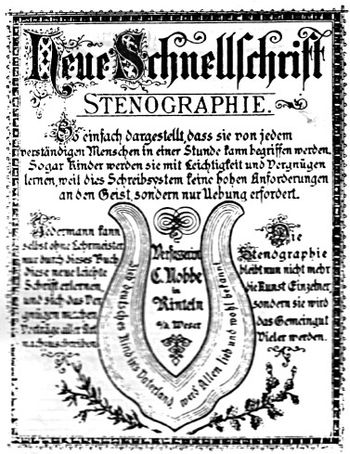Catherine Nobbe
Catherine Nobbe , b. Siebert (born December 17, 1830 near Kassel ; † December 27, 1886 ) was a music teacher and developed a stenography system for the German language . Along with Sophie Scott, Catherine Nobbe is the only known female inventor of a German-language shorthand system and thus went down in shorthand history.
Life
Catherine Nobbe was born as the eldest daughter of the farmer Siebert in 1831 on the Kragenhof near Kassel. Her parents died at the age of five. Relatives in Kassel raised her after the death of her parents and enabled her to attend a private school . In 1852 she married the master baker Wilhelm Nobbe in Rinteln on the Weser . After twelve years her husband died and a few years later her only son died. From now on she gave music lessons . Catherine Nobbe died on December 27, 1886.
Work in the shorthand field
Catherine Nobbe dealt intensively with shorthand for fourteen years - especially during her time as a music teacher. She developed her own shorthand system and wrote in her foreword on November 17, 1885: “Perhaps it would be good if I had waited a little longer with publication, partly to improve more and more through even longer practice, partly to improve myself to be able to write as quickly as no other system can; but God can soon set a goal for a life ... ”Catherine Nobbe seemed to have premonitions of death when writing this foreword. Her textbook was announced in a supplement to a Cologne music newspaper at the end of 1886 at a price of 6 marks.
The textbook comprised a total of 118 pages. The preface was made up of seven pages; on six Nobbe's system was presented with explanations. The vast majority of the book was made up of writing and reading exercises. The reading and writing exercises in Nobbe's textbook are from the Bible . Catherine Nobbe writes in the foreword of her shorthand textbook: “I used the Bible for my own practice because I didn't feel like studying another book in such depth. I have now kept it as the most suitable book for teaching, because working through it can only bring blessings and because it can be found in everyone's home. "
The inventor of the shorthand system, Catherine Nobbe, used the five staves as shorthand ruling - obvious for a piano teacher . Of a consonant follows a vowel their Stenografiesystems was, o, u shown symbolically in the order a, e, i in the following Mitlautzeichen by the position from bottom to top in the Lineatur. The writing and suggestion of umlauts , double sounds , etc. a. was clarified by various rules.
Catherine Nobbe's sister mastered this system and corresponded with her in shorthand. According to her sister's statements, the system inventor herself wrote around 110 syllables per minute with her own shorthand system.
Catherine Nobbe thought that the shorthand system developed before her was also suitable for foreign languages. Catherine Nobbe was very likely familiar with other shorthand systems. In her foreword she indicated this: “The male acumen has not yet succeeded in presenting the matter so simply that everyone can enjoy the benefit of being able to write quickly. Now the Lord God has given it to a woman who is not in the least learned, no, to a very simple woman ... "At the end of her preface it says:" Perhaps it would be good if I had waited before the publication, on the one hand, for myself first to be able to write as quickly as no other system can; But the good Lord can soon set a goal for a life, and I would not like, if it is God's will, to take what he gave me, and what has cost hard work and diligence, with me under the earth, but rather it from humanity as I hope to God, given as a blessing. "
Catherine Nobbe's wish did not come true. Your system had no further significance on future shorthand development and application.
literature
- Carl Faulmann : History and literature of shorthand . Bermann & Altmann, Vienna 1894.
- Peter Knopka: Catherine Nobbe. A German inventor of shorthand . In: Deutsche Stenografenzeitung 11, 1980, ISSN 0011-5169 , pp. 233-235.
- Heinrich Krieg: Catechism of the shorthand. A guide for teachers and learners of shorthand in general and the Gabelsberger system in particular . 2nd increased edition. JJ Weber, Leipzig 1888, ( Weber's illustrated catechisms 37).
- Shorthand inventors . In: The stenography teacher. Journal for the Promotion of Education and Scientific Research for Shorthand and Typewriting 3, 1950, ISSN 0176-2311 , pp. 94-95
| personal data | |
|---|---|
| SURNAME | Nobbe, Catherine |
| BRIEF DESCRIPTION | Inventor of a German-language stenography system |
| DATE OF BIRTH | 1831 |
| PLACE OF BIRTH | near Kassel |
| DATE OF DEATH | December 27, 1886 |
